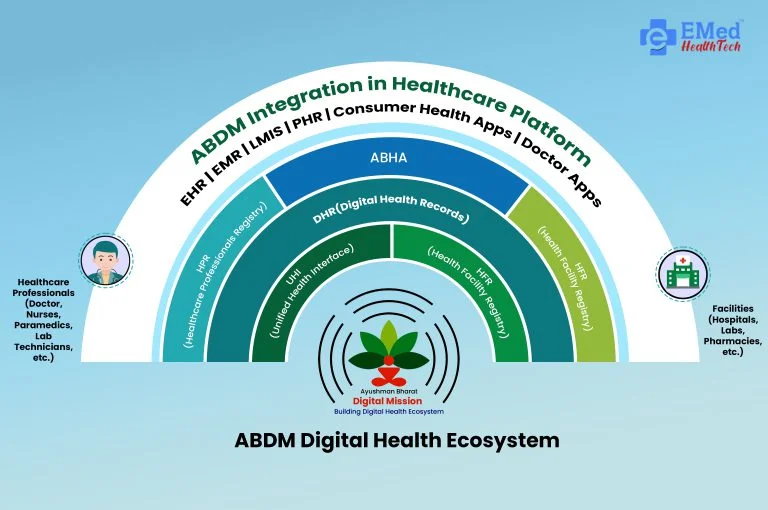ABDM/Abha Integration

The Ayushman Bharat Digital Mission (ABDM) is a major initiative by the Government of India aimed at building a robust and integrated digital health infrastructure. A core component of this mission is the seamless integration with Hospital Information Systems (HIS), also known as Hospital Management Information Systems (HMIS), and other digital health solutions.
ABDM Integration with HIS:
Integrating ABDM with existing HIS systems means that hospitals, clinics, and diagnostic centers can communicate and exchange health information within the larger ABDM ecosystem. This is achieved through:
- Standardized APIs: ABDM provides open Application Programming Interfaces (APIs) and standards that HIS/HMIS developers use to connect their systems.
- ABDM Sandbox: A testing environment for developers to validate their software with ABDM APIs before live implementation.
- Key Building Blocks for Integration:
- Ayushman Bharat Health Account (ABHA) Number: Unique 14-digit health IDs. HIS systems help patients create and link these to their records.
- Health Facility Registry (HFR): Hospitals register here, making them discoverable within ABDM.
- Healthcare Professionals Registry (HPR): Healthcare professionals register here for verification and linking to the system.
- Personal Health Records (PHR) Apps: Patients use these apps (like the ABHA app) to view and manage their records, securely shared from HIS with consent.
- Health Information Provider (HIP) Services: Hospitals, through their HIS, share digital health records with patient consent.
- Health Information User (HIU) Services: Authorized professionals can access records from other providers via their HIS, with patient consent.
- National Health Claims Exchange (HCX): Standardizes the insurance payment ecosystem; HIS can integrate for easier claim management.
- Scan and Share OPD Registration: HIS systems enable QR-code based OPD registration to streamline patient check-ins.
Benefits of ABDM Integration with HIS: A Win-Win
This integration offers significant advantages for all stakeholders:
For Patients:
- Enhanced Access to Healthcare: Patients can access their digital health records anytime, anywhere, eliminating the need for physical documents.
- Patient Empowerment: Patients gain control over their health data, allowing them to easily access, manage, and share their medical history with authorized providers.
- Reduced Waiting Times: Features like QR-code based OPD registration significantly cut down on queues and manual entry.
- Improved Continuity of Care: Healthcare providers have instant access to comprehensive health histories, leading to better diagnosis, treatment, and follow-up.
- Convenience and Portability: ABHA numbers and linked digital records make accessing medical services more convenient and portable.
For Healthcare Providers:
- Efficient Data Management & Exchange: Centralized data management improves accuracy, reduces redundancies, and facilitates seamless information exchange.
- Streamlined Operations: Digitizing records and processes reduces paperwork and administrative overhead.
- Faster & More Accurate Diagnoses: Professionals have immediate access to critical patient information, leading to quicker and more precise diagnoses.
- Improved Quality of Care: Longitudinal health records help track trends, assess treatment progress, and improve overall health outcomes.
- Data-Driven Decision Making: The wealth of data can be analyzed to identify disease patterns and inform healthcare planning.
- Increased Visibility: Registering on HFR enhances a facility's online presence and discoverability.
- Digital Health Incentive Scheme (DHIS): Facilities can earn financial incentives for adopting ABDM and digitizing records.
For the Overall Healthcare System:
- Interoperability: ABDM establishes a standardized framework for data exchange, fostering a truly interconnected healthcare ecosystem.
- Universal Health Coverage: Leveraging technology to provide affordable, accessible, and inclusive healthcare for all citizens.
- Strengthened Infrastructure: Promotes the adoption of robust IT systems, connectivity, and cybersecurity across the country.
- Transparency & Accountability: Digital records and transactions enhance transparency within the healthcare system.
In essence, the integration of ABDM with HIS is pivotal in transforming India's healthcare landscape, creating a seamless, interconnected, and patient-centric digital health ecosystem.

